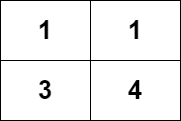You are given an m x n integer matrix grid, where you can move from a cell to any adjacent cell in all 4 directions.
Return the number of strictly increasing paths in the grid such that you can start from any cell and end at any cell. Since the answer may be very large, return it modulo 109 + 7.
Two paths are considered different if they do not have exactly the same sequence of visited cells.
Example

Input: grid = [[1,1],[3,4]]
Output: 8
Explanation: The strictly increasing paths are:
- Paths with length 1: [1], [1], [3], [4].
- Paths with length 2: [1 -> 3], [1 -> 4], [3 -> 4].
- Paths with length 3: [1 -> 3 -> 4].
The total number of paths is 4 + 3 + 1 = 8.
Solution
Great solution found here
var countPaths = function (grid) {
//Set up variables
let mod = Math.pow(10, 9) + 7;
let result = 0;
let rows = grid.length,
columns = grid[0].length;
//Create a dp array
let dp = Array(rows)
.fill(null)
.map((_) => Array(columns).fill(0));
//DFS function that returns the number of paths
const dfs = (r, c, preVal) => {
if (r < 0 || r == rows || c < 0 || c == columns || grid[r][c] <= preVal)
return 0;
if (dp[r][c]) return dp[r][c];
return (dp[r][c] =
(1 +
dfs(r + 1, c, grid[r][c]) +
dfs(r - 1, c, grid[r][c]) +
dfs(r, c + 1, grid[r][c]) +
dfs(r, c - 1, grid[r][c])) %
mod);
};
//Recursive call to dfs
for (let i = 0; i < rows; i++) {
for (let j = 0; j < columns; j++) {
result += dfs(i, j, -1) % mod;
}
}
return result % mod;
};